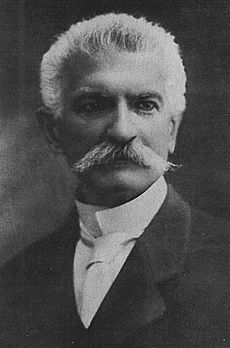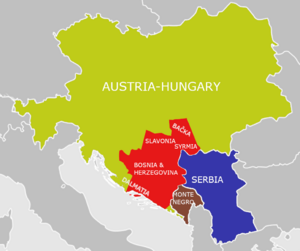Treaty of London (1915) facts for kids
| Agreement between France, Russia, Great Britain and Italy. Signed at London April 26, 1915. | |
|---|---|
| Type | Multilateral treaty |
| Context | Entry of Italy into World War I |
| Signed | 26 April 1915 |
| Location | London, England, United Kingdom |
| Negotiators |
|
| Signatories |
|
| Parties | |
The Treaty of London (also known as the Pact of London) was a secret deal made on April 26, 1915. It was signed by the United Kingdom, France, and Russia on one side, and Italy on the other. The main goal was to convince Italy to join World War I with the Triple Entente (the Allies).
Italy was promised new lands if it joined the war. These lands would come from Austria-Hungary and the Ottoman Empire. Italy was also promised more land for its colonies in Africa. The Allies hoped Italy's entry would make the Central Powers (like Germany and Austria-Hungary) spread their armies thinner. They also hoped it would encourage Romania and Bulgaria to join them.
In May 1915, Italy declared war on Austria-Hungary. But it waited a whole year before declaring war on Germany. This delay made France and the UK unhappy. After the war, at the Paris Peace Conference, the United States tried to cancel the treaty. They felt it went against the idea of self-determination, which means people should choose their own government.
A new agreement was made at the conference. Italy received less land than promised. It got Trentino and the Julian March. It also occupied the city of Vlorë and the Dodecanese Islands. Italy had to settle its eastern border with the new Kingdom of Serbs, Croats and Slovenes. This was done through the Treaty of Rapallo. Italy gained Istria and the city of Zadar (an enclave in Dalmatia). It also got several islands along the eastern Adriatic Sea coast. However, the Allies did not give Italy the promised expanded colonies or a part of Asia Minor.
Contents
Why Was the Treaty Needed?
Soon after World War I began, the Triple Entente powers (the United Kingdom, France, and Russia) wanted more allies. They first tried to get Italy to join them in August–September 1914. Italy was part of the Triple Alliance with Germany and Austria-Hungary, but it had declared neutrality.
The Allies also tried to get Bulgaria to join them. They offered Bulgaria land from Serbia. In return, Serbia was promised land from Austria-Hungary, like Bosnia and Herzegovina and access to the Adriatic Sea.
How Were the Negotiations Conducted?
Early Discussions with Italy
The first talks between the Allies and Italy happened in 1914. Russia suggested them. On August 4, Italy's ambassador to Russia said Italy might join the Allies. Italy wanted Trentino, Vlorë, and a strong position in the Adriatic Sea.
Russian Foreign Minister Sergey Sazonov liked this idea. He thought Italy joining would also make Romania join the Allies. British Foreign Minister Edward Grey agreed. He suggested adding Trieste to Italy's demands to get public support in Italy.
Italy's ambassador to the UK, Guglielmo Imperiali, told Grey Italy's conditions. But Grey felt the talks wouldn't go anywhere unless Italy promised to join the Allies first. Britain's ambassador to Italy, Rennell Rodd, asked Italian Prime Minister Antonio Salandra if Italy could join the war. Salandra said it was too early. He felt joining too soon would ruin any future alliance. Russia then dropped the idea for a while.
Italy's Reasons for Joining
The Allies wanted Italy to join to force Germany to move its troops. Italy, however, had its own reasons. It wanted to gain lands that it felt belonged to Italy, especially from Austria-Hungary. It also wanted to control the Adriatic Sea and expand its colonies.
Most Italians initially wanted to stay neutral. But some groups wanted war against Austria-Hungary. These groups, called "irredentists," saw the war as a chance to unite Italian-speaking lands.
Taking Control of Vlorë
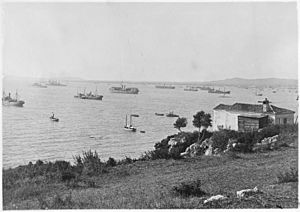
Prime Minister Salandra and his foreign minister, Antonino Paternò Castello, kept the talks open. They waited for the right moment to increase Italy's demands. Castello told Rodd that Italy and Britain shared an interest in stopping Slavic influence in the Adriatic. He meant stopping Russia from gaining too much power there.
Castello said Italy wouldn't join the war until its conditions were met. But Grey insisted Italy commit first. So, the talks broke down again. A British official, Arthur Nicolson, worried about Italy taking Dalmatia. He said that if Italy took Dalmatia, it would have problems with its large South Slavic population.
Despite this, Castello got Britain to agree to Italy occupying Vlorë. This move was a step towards Italy joining the war. It also gave the Italian government more prestige.
New Foreign Minister, New Talks
In November, Sidney Sonnino became Italy's new foreign minister. He continued talks with Rodd. Sonnino suggested a non-binding agreement first. Rodd learned that the Italian army would be ready by February 1915. He urged Grey to consider Sonnino's offer. But Grey was not very interested in an Italian alliance at that point.
Salandra and Sonnino then talked with the Central Powers. This was likely to keep them calm while Italy continued talks with the Allies. These talks with the Central Powers failed on February 15, 1915. The next day, Sonnino sent a list of 16 conditions for Italy to join the war.
Russia's Concerns and Final Deal
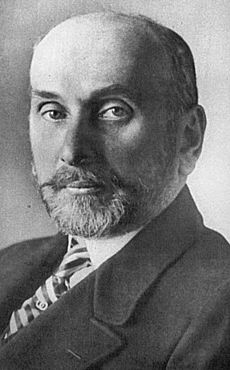
Grey thought Italy's demands were high but didn't conflict with British interests. He also believed Italy's help would speed up decisions from Bulgaria and Romania.
Sazonov, the Russian foreign minister, worried about Italy's role near Constantinople. Russia wanted control of that city. Grey then got Britain and France to formally agree to Russia's claim over Constantinople. This made Sazonov agree to a deal with Italy. However, he didn't want Italy to take the Adriatic coast south of Split. He also didn't want Italian troops to help capture the Turkish Straits.
The talks continued for six weeks because Sazonov still disagreed on how much land Italy would get in Dalmatia. Italy wanted Dalmatia up to the Neretva River for security reasons. They said Russia might take the Austrian coast, and Italy needed a strong port.
The French Foreign Minister, Théophile Delcassé, helped break the stalemate. He was willing to pay any price for Italy's alliance. Delcassé suggested Italy get less land in Dalmatia to help Serbia. In return, Italy would get full control of the Dodecanese Islands. This worked because the Russian army was struggling. Russia urgently needed Italy's help.
Sazonov accepted the new proposal. He insisted Italy join the war by the end of April. British Prime Minister H. H. Asquith finalized the draft agreement on April 9. Sonnino accepted it with small changes five days later. The agreement was signed on April 26 by Grey and the ambassadors from France, Italy, and Russia.
What Were the Terms of the Treaty?
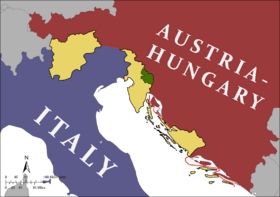
The treaty had several key points:
- Article 1: A military agreement would be made. Russia would commit troops against Austria-Hungary to help Italy.
- Article 2: Italy had to declare war on all enemies of the UK, Russia, and France.
- Article 3: The French and British navies would help Italy by fighting the Austro-Hungarian Navy.
Land Gains in Europe
- Article 4: Italy would get Trentino and the South Tyrol. A new border would be drawn between Italy and Austria. This border would leave Rijeka just outside Italian territory.
- Article 5: Italy would receive Dalmatia, including the cities of Zadar and Šibenik. It would also get most of the Austro-Hungarian Adriatic islands. The rest of the coast would go to Croatia, Serbia, and Montenegro. This article also said parts of the coast would be demilitarized. This was to ensure Italy had military control in the region. These land gains meant about 200,000 German speakers and 600,000 South Slavs would become part of Italy.
- Articles 6 and 7: Italy would get full control over Vlorë and the Sazan Island. Italy would represent Albania in foreign matters. But Italy had to agree if Albania was divided between Serbia, Montenegro, and Greece.
- Article 8: Italy would get full control over the Dodecanese Islands.
Promises Outside Europe
- Article 9: Italy was promised land around Antalya if the Ottoman Empire was divided.
- Article 10: Italy gained rights in Italian Libya that used to belong to the Ottoman Sultan.
- Article 13: Italy was promised compensation if France or Britain gained land from Germany's colonies in Africa.
- Article 12: Italy supported the Allies' plan for an independent Muslim state to control Mecca and Medina.
Financial and Other Terms
- Articles 11 and 14: Italy was promised a share in any war payments and a loan of 50 million pounds sterling.
- Article 15: The Allies would support Italy's wish to keep the Holy See (the Pope's government) out of war settlements.
- Article 16: The treaty was to be kept secret.
What Happened After the Treaty?
Italy Joins the War
Before Italy joined the war, there was a lot of excitement and debate in the country. Speeches by Gabriele D'Annunzio encouraged war. This time was called the radiant days.
On May 22, 1915, Italy declared war only on Austria-Hungary. This went against Article 2 of the treaty, which said Italy must fight all Central Powers. France accused Italy of breaking the treaty. Russia wondered if Italy had a secret deal with Germany. Italy said its army wasn't ready to fight Germany. This made Italy feel isolated among the Allies. Italy finally declared war on the Ottoman Empire on August 20. It didn't declare war on Germany until August 27, 1916.
Italy faced a tough war. It was almost defeated in 1917 at the Battle of Caporetto. After a big retreat, Italian forces recovered and won the Battle of Vittorio Veneto a year later. This came at a high cost: 600,000 dead soldiers, social problems, and a damaged economy. Under the Armistice of Villa Giusti, Italy was allowed to occupy Austro-Hungarian land promised by the Treaty of London. Italian troops moved into these areas on November 3, 1918.
Italy joining the war did not convince Bulgaria to join the Allies. Bulgaria became more careful after early British and French losses. Bulgaria joined the Central Powers on October 6 and attacked Serbia five days later.
Agreement of Saint-Jean-de-Maurienne
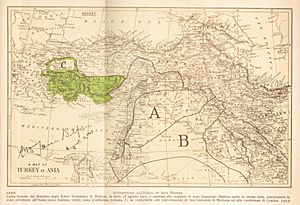
The Allies discussed dividing the Ottoman Empire in 1917. Italy wanted its promised land around Antalya. To get a fair share compared to its allies, Italy also asked for more land in the Konya and Adana regions. Most of Italy's demands were accepted in the Agreement of Saint-Jean-de-Maurienne. However, France said Russia had to confirm the agreement. This became impossible after the Russian Revolution.
The Paris Peace Conference
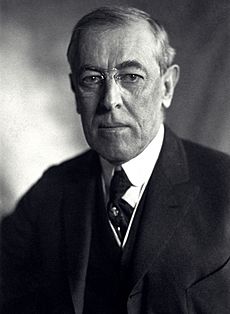
The Treaty of London caused big arguments between Italy and the other Allies at the Paris Peace Conference. Italy's leaders, Prime Minister Vittorio Emanuele Orlando and Sonnino, wanted the treaty to be fully enforced. They also wanted to take Rijeka. Britain and France didn't publicly support Italy's claims beyond the treaty. They privately felt Italy deserved less because it was slow to fight Germany.
The US President, Woodrow Wilson, strongly opposed the Treaty of London. He believed it was an example of bad European diplomacy. He argued the treaty was no longer valid because conditions had changed after Austria-Hungary broke apart. Wilson published a statement on April 24, 1919, explaining his views. Orlando and Sonnino left Paris in protest. They were seen as heroes in Italy for standing up for their country.
When the Italian delegation was gone, France and Britain decided to cancel the Agreement of Saint-Jean-de-Maurienne. This was because Russia hadn't agreed to it. They also decided not to honor any of Italy's claims in Asia Minor or Africa.
Orlando and Sonnino disagreed on what land to claim on the eastern Adriatic coast. Orlando was willing to give up Dalmatia (except Zadar and Šibenik) but wanted Rijeka. Sonnino wanted the opposite. This led to the popular slogan "Pact of London plus Fiume" (Rijeka). This meant demanding both the treaty promises and Rijeka.
In the end, Italy's gains on the eastern Adriatic coast were limited. It received the Julian March, Istria, and some islands. Rijeka became an independent city. Italy also gained some border corrections around Tarvisio, giving it a direct rail link with Austria. In Dalmatia, Italy only got Zadar and some islands. In a secret deal, Italy gave up its claims over the Dodecanese Islands (except Rhodes) to Greece.
See also
- Treaties of Rome – Treaties from 1941 that gave Italy parts of Dalmatia it had been promised earlier.
Sources
 Agreement between France, Russia, Great Britain and Italy, signed at London, April 26, 1915. London: H.M. Stationery Office. Wikisource. 1920. OCLC 807191361.
Agreement between France, Russia, Great Britain and Italy, signed at London, April 26, 1915. London: H.M. Stationery Office. Wikisource. 1920. OCLC 807191361.



